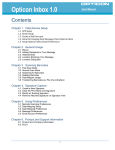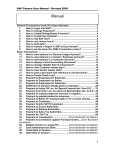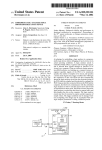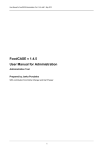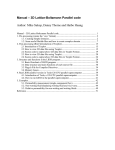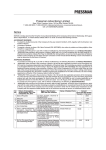Download Short-term power dropout arrangement useful in a television receiver
Transcript
United States Patent [191 [l 1] 4,249,089 Wolford et 111. [45] Feb. 3, 1981 [54] [75] SHORT-TERM POWER DROPOUT ARRANGEMENT USEFUL IN A TELEVISION RECEIVER OTHER PUBLICATIONS "COP Microcontroller Family Chip User Manual”, National Semiconductor, FIG. 2.4, p. 12, Sep. 1978. Inventors: James J. Wolford; John B. George, both of Indianapolis, 1nd. [7 3] Assignee: RCA Corporation, New York, N.Y. [7-1] Appl. No: 52,660 Primary Examiner-L. T. I-Iix Assistant Examiner-James L. Dwyer Attorney, Agent, or Firm-Eugene M. Whitacre; Paul J. Rasmussen; Peter M. Emanuel [57] ABSTRACT The control portion of a television receiver includes a ?ip ?op which when supplied with operating power [22] Filed: Jun. 27, 1979 stores a binary signal having either an “on" level corre sponding to the on condition of the receiver or an “ofF’ Int. Cl.3 ........................................... .. HOIH 83/00 [51] [52] US. Cl. [53] [56] 307/140; 307/200 B; 307/142; 365/228 Field of Search ................. .. 307/66, 64, 125, 126, 307/140, 200 A, 200 B, 142, 141,296 R; 365/228, 229; 358/190; 325/492 References Cited U.S. PATENT DOCUMENTS 3,558,912 l/l97l 3,575,612 4/1971 3,786,282 l/l974 4,052,701 10/1977 4,056,808 11/1977 4,099,372 7/1978 level corresponding to the off condition of the receiver. In addition to a user responsive input arrangement for selectively controlling the level of the binary signal, a switching circuit is coupled to the ?ip ?op to return the binary signal to its prior level after power line dropouts having less than a predetermined duration, and other wise causing the binary signal to have its “011" level. The switching circuit is rendered operative at the end of power line dropouts to cause the binary signal to have its “on" level if an enabling signal selectively developed Spall ............................ r. 307/200A by a circuit including a capacitor and a diode connected 307/238 between the Hip Hop and capacitor during the presence of operating power is still stored in the capacitor. 5 Claims, 1 Drawing Figure STANDBY POWER 1 4,249,089 2 the binary signal to its ?rst level if the enabling signal is still present and to otherwise set the binary signal to its SHORT-TERM POWER DROPOUT second level. ARRANGEMENT USEFUL IN A TELEVISION RECEIVER BRIEF DESCRIPTION OF THE DRAWING The sole FIGURE shows partially in block diagram BACKGROUND OF THE INVENTION The present invention pertains to the ?eld of arrange form and partially in schematic diagram form an ar rangement constructed in accordance with the present ments for maintaining the operational status of an elec invention for maintaining information pertaining to operational conditions of systems employed in a televi sion receiver. DETAILED DESCRIPTION OF THE DRAWING trical system during short-term power dropouts. Systems which derive their operating voltages from the AC power line are susceptible to temporary inter ruptions of their operation due to short-term power line dropouts which occur, for example, when lightning strikes near a power line. Power line dropouts tend to annoy a user even if shot In the sole FIGURE, a television receiver includes an antenna 1, a tunner 3, an IF signal processing unit 5, a term, since information related to particular operating picture processing unit 7, a de?ection unit 9, a picture tube 11, a sound signal processing unit 13, and a speaker conditions of the system may be lost during the power line dropout necessitating that the user reset the system to the prior operating conditions after power returns. This is particularly the case with systems employing digital electrical control arrangements rather than me chanical ones since the latter arrangements have inher ent memory capabilities. Not only are dropouts annoying, but when line 15 arranged in a conventional fashion. Tuner 3 includes frequency tuning elements, e.g., tuned circuits including varactor diodes (not shown) responsive to a tuning voltage generated by a tuning voltage generator 17 to tune the receiver to various channels in the television frequency range. The components of the receiver so far described are enclosed within a signal processing por tion 19 and receive operating voltages, indicated sym bolically by a single line 21, from a main power supply power returns, the system may be set to undesirable operating conditions. For example, in a television re ceiver in which information related to whether the (P.S.) unit 23. receiver is off or on is stored in a memory cell, when A user responsive control unit 25 generates control power returns after a dropout, the memory cell may be signals for selecting the on and off states of the receiver, 30 set to a state corresponding to the on condition of the the volume level of the receiver and the channel to receiver even though the receiver was intentionally turned off before the dropout occurred. While arrange ments are known for resetting digital control arrange which the receiver is tuned. Control unit 25 generates the various control signals in response to the depression of ON/OFF, V. UP (Volume UP), V. DN (Volume ments to a predetermined state when power returns, the DowN), C. UP (Channel UP) and C. DN (Channel predetermined state may not necessarily correspond to the condition of the system before the power line drop DowN) keys of a keyboard 27 mounted on the receiver. Each key of keyboard 27 includes a normally opened switch which is closed when the key is depressed by a having to return the system to its previous condition. user and returns to its normally opened position when A variety of standby power supply arrangements are known for maintaining the operation of a system or 40 the key is released. when a key of keyboard 27 is depressed, a low logic information related to operating conditions of a system out occurred. As a result, the user may be annoyed by during power line dropouts. Typically, these employ a level signal, i.e., a signal at ground potential, is coupled power storage element such as a battery or a capacitor. to a decoder 29 included with control unit 25. In re sponse, decoder 29 generates a respective one of an Batteries are undesirable since they require replacement by the user or recharging circuitry. While relatively small value capacitors may be employed as power stor age elements in systems which have digital control apparatus requiring relatively small amounts of operat ing power, relatively large value capacitors are needed for storage elements in systems which have digital con trol apparatus requiring relatively large amounts of operating power. Since the storage capacity of a capaci tor is related to its size, the use of a capacitor as a power storage element can be undesirable. Moreover, both batteries and relatively large value capacitors tend to be expensive. 45 ON/OFF IN, V. UP, V. DN, C. UP or C. DN control signal. The ON/OFF IN, V. UP, V. DN, C. UP and C. DN signals are also generated in response to the opera tion of ON/OFF, V. UP, V. DN, C. UP and C. DN keys located on a battery powered remote control trans mitter 31. In response to the operation of the keys of transmitter 31, encoded carrier signals which, for exam ple, are generated by remote control transmitter 31 and coupled to decoder 29 through a remote control re ceiver input unit 33, including a transducer, ampli?er and demodulator (not shown) arranged in conventional fashion. Decoder 29 decodes the demodulated output signal of receiver input unit 33 to generate the ON/ OFF IN, V. UP, V. DN, C. UP and C. DN signals. In a system including memory means for storing a The ON/OFF IN signal is applied on an ON/OFF 60 binary signal having ?rst and second levels correspond toggle FF (Flip Flop) 35 included within control unit SUMMARY OF THE INVENTION ing to ?rst (e. g., "on“) and second (e.g., “ofl") operating conditions of the system during the presence of operat ing power, storage means are coupled to the memory 25. ON/OFF FF 35 is alternately set and reset in re sponse to the generation of successive ON/OFF IN signals. The output signal of ON/OFF FF 35, hereinaf means for selectively developing an enabling signal in ter referred to as the ON/OFF OUT signal, is coupled 65 response to the first level and storing the enabling signal to a relay driver including an NPN transistor 37 ar for a pre-determined time after the start of power drop ranged in a common emitter configuration to selectively outs. Switching means coupled to the memory means is apply current to a relay coil 39 coupled to its collector. rendered operative at the end of power dropouts to set 3 4,249,089 A diode 41 shunts coil 39 to suppress the development of transients. When the ON/OFF OUT signal has a high logic level, transistor 37 is conductive and relay coil 39 is energized. When the ON/OFF OUT signal has a low logic level, transistor 37 is nonconductive and relay coil 39 is unenergized. When coil 39 is energized, relay contacts 43 are closed. As a result, AC line voltage is applied to main power supply 23, causing operating voltages to be applied to signal processing portion 19 to turn the receiver on. When coil 39 is unenergized, the receiver is turned off. The V. UP and V. DN signals are applied to a volume 4 causes the ON/OFF OUT signal of ON/OFF FF 35 to be set to the low logic level so that the receiver is off. The POR 1 pulse also causes decoder 29, volume regis ter 45 and D/A converter 47 to be set to predetermined states such that when the receiver is initially turned on, the volume level will be at approximately 50% of its maximum value. When voltage V5 is initially devel oped, a negative-going POR 2 signal is developed at the junction of resistor 61 and capacitor 63 and applied to the R input of channel number register 49. The POR 2 pulse causes the stages of channel number register 49 to be set to predetermined states such that when the re ceiver is initially turned on, the receiver will be tuned to a analog (D/A) converter 47 is responsive to the binary 5 predetermined channel such as, e.g., the lowest fre quency channel. signal contents of volume register 45 to generate an register 45 included within control unit 25. A digital-to The V1-V5 outputs of standby P.S. 51 have, in effect, respective ?lter capacitors C1-C5 associated with them. In the absence of AC line voltage, capacitors C1-C5 response to the V. UP signal thereby causing the vol ume of the receiver to be increased. Similarly, the vol 20 will maintain voltages V1-V5 above levels necessary for storing information in the load circuits to which they ume of the receiver is decreased in response to a V. DN signal. are coupled for time periods determined by the current requirements of the respective load circuits. Since chan The C. UP and C. DN signals are coupled to a chan nel number register 49 has a relatively low current nel number register 49 outside of control unit 25. The contents of channel number register 49 are increased 25 requirement, ?lter capacitor C5 need only have a rela tively low capacitance value to maintain voltage V5 and decreased in response to the C. UP and C. DN above a level necessary for storing binary signals in signals, respectively. Tuning voltage generator 17 gen erates the tuning voltage for tuner 3 in response to the channel number register 49 representing the channel ampli?er gain control signal for sound processing unit 13. The contents of volume register 45 are increased in contents of channel number register 49. For this pur number last selected for a time period greater than the pose, tuning voltage generator 17 may include a phase 30 duration, e.g., 2 seconds, of most short-term power line locked loop. The AMI model number S2601 integrated circuit commercially available from American Microsystems, dropouts. However, since control unit 25 has relatively high current requirements, ?lter capacitors C1 and C2 need have relatively high capacitance values to main Inc., Santa Clara, California, is suitable for use as con tain voltages V1 and V2 above levels necessary for trol unit 25. 35 storing binary signals in ON/OFF FF 35 and in volume Operating voltages for control unit 25, remote con trol receiver input circuit 33, relay coil 39, and channel register 45 representing the on/off and volume level conditions of the receiver even during relatively short term power line dropouts. number register 49 are generated by a standby power supply 51. Specifcially, P.S. 51 provides a positive oper Capacitors having relatively large capacitance values ating voltage V1 and a negative operating voltage V2 to 40 tend to be bulky and expensive and are therefore unde control unit 25, a positive operating voltage V3 to re sirable. Even so, conventionally large value ?lter capac mote control receiver input circuit 33, a positive operat itors have been employed to maintain information con~ ing voltage V4 to relay coil 39, and a positive operating cerning operating conditions of a receiver during short voltage V5 to channel number register 49. term dropouts to avoid the inconvenience to a user of Standby power supply 51 is continuously applied to 45 re-establishing the operating conditions of the receiver the line. As a result, except during power line dropouts, of the undesirability of having the receiver set to an discussed below, control unit 25 is in condition to pro cess commands initiated by a user by means of keyboard 27 mounted on the receiver or the keyboard of remote control transmitter 31. In addition, even though the receiver is off, i.e., relay contacts 43 are opened, operat ing voltage for volume register 45 and channel number register 49 is maintained. As a result, the volume level and channel which were last selected are maintained even while the receiver is off. To initialize the operating conditions of the receiver when line voltage is ?rst applied to the receiver, i.e., undesired condition after a short-term power line drop out as discussed earlier. In the present arrangement, circuitry is employed having capacitors with relatively low capacitance val ues for automatically setting ON/OFF FF 35 to the state corresponding to the prior on or off condition of the receiver after a short-term power dropout. In addi tion, although the prior volume level is not maintained during the power line dropout, the volume is set to a level 50% of its maximum value in response to the gen eration of a POR 1 pulse when voltage V1 is again developed after the power line dropout. The 50% vol signals are generated by power-up detectors 53 and 55 ume level is selected since it, at least statistically, ap and applied to control unit 25 and channel number reg 60 proximates the volume level selected by a user prior to ister 49, respectively, to reset these units to predeter the power line dropout. mined states. Power-up detector 53 includes a resistor The short-term power line dropout circuitry for auto 61 and a capacitor 63 connected in series between the matically setting ON/OFF FF 35 to its prior state after V1 output of RS. 51 and signal ground. When voltage a short-term power dropout includes an electronic V1 is initially developed, a negative~going POR (Power switch 65 including four NPN transistors 67, 69, 71, 73 On Reset) 1 pulse is developed at the junction of resistor having their collector-emitter junctions connected in 57 and capacitor 59 and coupled to reset (R) inputs of series between a conductor 87 at the on/off input of various portions of control unit 25. The POR 1 pulse decoder 29 and signal ground. Transistors 67,69, 71 and when the receiver is “plugged in" to an AC outlet, reset 5 4,249,089 73 are con?gured so that switch 65 function as a logic NAND gate. One input of switch 65, at the base of transistor 71, is connected to a capacitor 75 through a resistive voltage divider 77. Capacitor 75 is selectively charged to a positive voltage when a diode 79, connected between the output of ON/OFF FF 35 and capacitor 75, is ren~ dered conductive. Diode 79 is conductive when the ON/OFF OUT signal has the high logic level and is nonconductive when the ON/OFF OUT signal has the low logic level. Accordingly, capacitor 75 is charged when the receiver is on and discharged when the re ceiver is off. As long as capacitor 75 is charged to a conduction threshold level (substantially equal to the sum of its base-to-emitter voltage drop and the collec tor-to-emitter voltage drop of transistor 73 when it is conductive), NAND con?gured switch 65 is enabled to connect the on/ol'f input decoder 29 at conductor 87 to 6 receiver to be turned on) except during a short enabling time interval, e.g., lasting 2.8 seconds after the end of the dropout. Speci?cally, when the dropout ends, volt age V1 is applied to the base of transistor 67 through a capacitor 89, which initially acts as a short circuit to satisfy the law of charge conservation. As a result, tran sistor 67 is enabled to be rendered conductive. Thereaf ter, due to a charging path to negative voltage V2 pro vided by a resistor 91, capacitor 89 begins to charge toward negative voltage V2 and the voltage at the base of transistor 67 begins to decrease. At the end of the enabling time interval, when the voltage at the base of transistor 67 falls below the turn-on threshold voltage of transistor 67, transistor 67 and, as a result, switch 65 are disabled from being rendered conductive. When a dropout occurs, voltages V1 and V2 rapidly approach a common potential, i.e., that of signal ground, because capacitors C1 and C2, respectively, are discharged into their respective load circuits. This con signal ground in response to the development of posi 20 dition causes capacitor 89 to rapidly discharge through tive voltages at the other inputs of switch 65. The value of capacitor 75 is desirably selected in a conductive diode 93. Diode 93 is rendered conductive conjunction with the impedance into which it dis when a dropout occurs because capacitor 89 is charged charges, i.e., the combined impedance of current di in normal operation so as to forward bias diode 93 when vider 77 and the impedance at the base of transistor 71, voltages V1 and V2 are reduced in amplitude at the so that it remains charged to a level higher than the 25 conduction threshold voltage of transistor 71 for 'a time longer than the expected time duration, e.g., two sec onds, of power line dropouts. Since the discharging impedance for capacitor 75 can be made relatively high, e.g., l megohms, the value of capacitor 75 can be rela tively low, e.g., 4.7 microfarads. Another input of switch 65 at the base of transistor 69 is connected to a pulse generating network 81 compris ing a resistive voltage divider 83 and a capacitor 85. When voltage V4 is generated after a short-term power 35 start of the dropout. Capacitor 89 is thereby discharged and initiallized in preparation for the termination of the power line dropout. The POR 1 signal developed by power-up detector 53 is coupled to still another input of switch 65 at the base of transistor 73 through a resistive voltage divider 95. Transistor 73 will only be enabled to be rendered conductive when the POR 1 signal returns to a high pulse generating network 81 and coupled to the base of logic level after the termination of the negative-going POR 1 pulse. Thus, switch 65 is disabled from being rendered conductive until control unit 25 has been reset in response to the negative-going POR 1 pulse. This level just as if a user had depressed the ON/OFF key of ing claims. line dropout, a positive-going pulse is generated by assures that the operation of switch 65 occurs when transistor 69. ll' capacitor 75 is still charged to a level control unit 25 is in a known condition. above the conduction threshold voltage of transistor 71 and positive voltages have been developed at the base 40 While the present invention has been described with reference to keys with normally opened input switches, of transistors 67 and 73, as will be described below, the it should be appreciated that the input switches may be positive-going pulse applied to the base of transistor 69 normally closed. In this case, switch 65 should be con will render switch 65 conductive. When switch 65 is ?gured to function as an AND gate rather than a conductive, signal ground potential is applied to a con NAND gate. of course, it is understood that these and ductor 87 connected to the on/off input of decoder 29. other modi?cations are contemplated to be within the In response, decoder 29 causes the ON/OFF OUT scope of the present invention as de?ned by the follow signal of ON/OFF FF 35 to be set to the high logic keyboard 27. ll‘ capacitor 75 was not originally charged before the 50 power line dropout, because the receiver was off and We claim: 1. In a system including power supply means for normally developing operating voltages for said system, the development of at least one of said operating volt the ON/OFF OUT signal had the low logic level, ages by said power supply means being subject to inter-. switch 65 will not be enabled and the positive pulse ruptions during power line dropouts, memory means developed by pulse generator network 81 will have no effect. Under these conditions, when the POR 1 pulse is 55 for storing a binary signal having ?rst and second levels corresponding to on and off operating conditions, re generated after the dropout ends, ON/OFF FF 35 will spectively, of said system during the presence of said be reset so that the receiver is off. The same occurs if one of said operating voltages, control means for estab the dropout lasts for a period longer than the dropout lishing said on and off operating conditions of said sys duration for which capacitor 75 is selected, e.g., two seconds. Thus, as long as a dropout has a duration shorter than the duration for which capacitor 75 is se lected, the receiver will be returned to its prior on or off condition. If a dropout has a duration longer than the tem in response to said binary signal, and user respon sive input means connected between a ?rst circuit point and said memory means for selectively applying a pre determined voltage developed at said ?rst point to said memory means, said binary signal being alternately set 65 to said ?rst and second levels when said predetermined will be turned off. voltage is sequentially applied to said memory means by A timing circuit 88, coupled to another input of said input means, apparatus for returning said system switch 65, at the base of transistor 67, inhibits switch 65 after said power line dropouts to the prior one of said from being rendered conductive (thereby causing the duration for which capacitor 75 is selected, the receiver 7 4,249,089 ?rst and second operating conditions prevailing at the onset of said power line dropouts, comprising: storage means for selectively developing an enabling signal in response to said ?rst level of said binary signal during the presence of said one of said oper 8 after said binary signal is reset to said second level after the ends of said power line dropouts. 2. The apparatus recited in claim 1 wherein: said input means includes a manually operable switch mechanism connected between said ?rst point and said memory means for selectively applying ‘said predetermined voltage to said memory means; and said switching means is connected to a point between said switch mechanism and said memory means. 3. The apparatus recited in claim 2 wherein: ating voltages and for storing said enabling signal for a ?rst predetermined time interval after the beginnings of said power line dropouts; and switch means including ?rst and second normally non-conductive devices connected in series be tween said ?rst point and a second point between said switching means includes third and fourth nor mally nonconductive devices connected in series said input means and said memory means for selec tively applying said predetermined voltage to said - with said ?rst and said second devices between said memory means when said ?rst and‘second devices are both conductive, said ?rst device of said switching means being conditioned to be conduc being coupled to said resetting means to be ren dered conductive after said binary signal is set to tive in response to said enabling signal; said switching means further including pulse generat to said inhibiting means to be rendered conductive ?rst point and said second point, said third device said second level, said fourth device being coupled ing means coupled to said power supply means for generating a pulse signal at the ends of said power line dropouts, said second device of said switching means being conditioned to be conductive in re sponse to said pulse signal; said switching means further including resetting 25 means coupled to said memory means for setting said binary signal to said second level in response to the development of a predetermined level of said one of said operating voltages after the ends of said power line dropouts; 30 said switching means further including inhibiting during said predetermined time interval after the ends of said power line dropouts. 4. The apparatus recited in claim 3 wherein: said ?rst, second, third and fourth devices are bipolar transistors having their collector-to-emitter junc tions connected in series between said ?rst and said second point and having their bases connected to respective ones of said storage means, said pulse generating means, said resetting means and said inhibiting means. 5. The apparatus recited in claim 1 or 4 wherein: said storage means includes a capacitor and a diode connected between said capacitor and said memory means, said diode being poled to conduct in re sponse to said ?rst level of said binary signal. means for inhibiting said ?rst and second devices of said switching means from being conductive ex cept during a second predetermined time interval ' 35 45 55 65 G I t t









